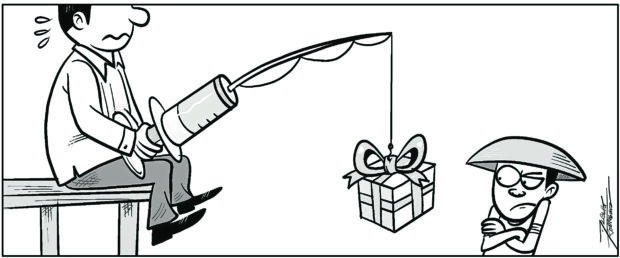
Local government units are bearing the brunt of the difficult task of convincing more Filipinos to get jabbed against COVID-19. With the education campaign on the benefits of vaccination hardly seen and heard — a problem compounded by the anti-Dengvaxia drive orchestrated by an administration ally, and a perceived state bias for China-made jabs that offer opaque trial results and other pertinent data — many Filipinos have had to rely on conflicting information and mixed signals from Malacañang to help them decide.
The result? Disturbing survey figures: Per Social Weather Stations, only three of 10 adult Filipinos are willing to get jabbed for free with a vaccine approved by the Food and Drug Administration; per Pulse Asia, 61 percent are unwilling, the No. 1 reason being safety concerns. Vaccine hesitancy has also been linked to brand preference, as aptly demonstrated by the huge crowd that converged on a site offering a lean supply of the American-made Pfizer vaccine, while elsewhere, inoculators at sites offering the ubiquitous made-in-China jab twiddled their thumbs for lack of takers.
LGUs are thus called upon to do the heavy lifting to overcome vaccine hesitancy. Among other things they are offering incentives including transport to and from vaccination sites and home service for those unable to make it out on their own, or raffle prizes such as 25-kilo sacks of rice. The lottery for the precious grain is, for example, done weekly in Sucat, Muntinlupa City—“the barangay’s gesture to thank the residents for their cooperation in the government’s vaccination program,” said the kapitan, Raffy Sevilla.
Makati Mayor Abby Binay has announced drive-through vaccination at the Circuit grounds both for the wealthy in their cars and those to be collected in tricycles from their homes and brought back after the deed is done. In Taguig City, there’s a bus for those to be jabbed, including those living in areas hard to reach. And as in the cities of Manila, Muntinlupa, Taguig, and Pasay, bedridden residents of Baguio are getting vaccinated at home. A six-member mobile vaccination team does the honors, ensuring that the “non-ambulatory” residents are properly screened, inoculated and monitored.
As though she were an LGU by and in herself, Deputy Speaker and Las Piñas Rep. Camille Villar has upped the ante and announced that a house and lot worth P1.5 million would be up for grabs for jabbed city residents. This windfall, with two motorcycles as consolation prizes, may be won in a grand yearend raffle — the cherry on top of P5,000 worth of gift packages to be offered monthly in July to 50 vaccinated winners. This project “will not only protect people but help our economy recover,” said the young lawmaker, a child of billionaire parents. Inspired, Mayor Jesus Bueno Jr. of Santa, Ilocos Sur, has promised jabbed residents “a chance to win, not just sacks of rice or discounts in restaurants, but [also] a house and lot package.”
But for all that and similar efforts, “the problem actually is there are not enough vaccines and vaccinators in some areas,” Philippine Medical Association president Benito Atienza was quoted as saying. Many Filipinos will find Atienza’s formulation correct according to their specific experience, from waiting so long to be called despite early registration, to getting called and dutifully waiting in line in a crowd only to be told after some hours that the vaccine supply had run out, to grappling with the sheer difficulty of registering. Success stories online or in print add insult to their injury. And last week, the national organization of city mayors had to formally urge the government to include as priority vaccine recipients other areas beyond “NCR Plus 8.”
It doesn’t help that Harry Roque disses Vice President Leni Robredo for supposedly volunteering to appear with his principal in an “infomercial for vaccine confidence” now that the jab program is “succeeding.” It’s a barefaced lie. Neither does it help that the Palace crows about the Philippines being second in Asean in terms of doses administered: 4.50 million after Indonesia’s 25.78 million, per Our World in Data as of May 25. Following the World Health Organization’s indicators for measuring the success of a vaccination program (uptake and coverage) and using Our World in Data’s latest figures, the Philippines is second to the last among the 10 Asean countries in terms of administered vaccines per 100 people. (The last on the list, Vietnam, has the lowest number of COVID-19 cases in the region.)
If Malacañang is to fight the pandemic alongside the LGUs, Roque should ditch the toxic messaging and stop fudging facts and figures.